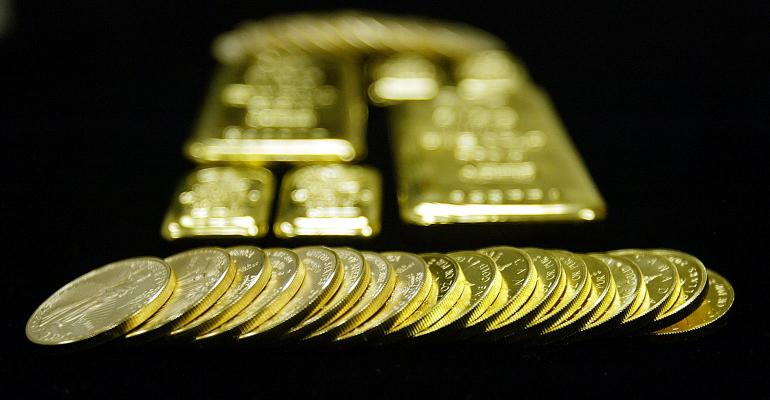By Luzi Ann Javier
(Bloomberg) --Gold is splitting the investment community down the middle.
Take the flows into and out of exchange-traded funds. Money has been draining out of SPDR Gold Shares, the world’s largest gold-backed ETF used by big institutional investors, each week since Nov. 11. But iShares Gold Trust, a smaller rival favored by individuals investing lesser amounts for themselves, has seen back-to-back weekly inflows.
Large mutual, pension and hedge funds are chasing better returns in rallying U.S. stock markets thanks to President-elect Donald Trump’s pro-growth policies. Retail investors including iShares Gold holders are returning to gold amid renewed concern that Trump protectionism will restrict global trade and growth. Those concerns were shared by more than two-thirds of traders surveyed by Bloomberg News last month, who forecast prices will gain this year as political uncertainties drive demand for haven assets including bullion.
Gold futures rose as much as 0.5 percent, before settling little changed Tuesday at $1,185.50 an ounce on the Comex in New York. Prices have risen 5.4 percent since hitting a 10-month low on Dec. 15. People familiar with China’s plans said last week the nation is prepared to retaliate should Trump take punitive measures against Chinese goods and trigger a trade war between the two biggest economies.
Last week, investors pulled $307.1 million from SPDR Gold, while iShares attracted $80.8 million, according to data compiled by Bloomberg.
“It looks like the hot money is showing a real negative sentiment towards gold and it’s expressing that in GLD,” Eric Balchunas, an ETF analyst for Bloomberg Intelligence, said, referring to SPDR Gold by its exchange ticker. “Retail investors and advisers seem to be continuing their allocation to gold through these other vehicles,” including iShares Gold, he said.
Instability Concerns
Former U.S. Treasury Secretary Lawrence Summers last week said investors are far too sanguine about the risks of Trump’s policies, which analysts at Eurasia Group said could contribute to a level of global instability not seen since World War II. Summers also said Trump’s plans for deregulation were setting the stage for the next financial crisis.
Gold may rally to $1,300 at the end of 2017, according to the median of the 26 estimates by analysts and traders surveyed by Bloomberg News last year from Singapore to New York.
While the uncertainties are sending retail investors and overseas buyers to the gold market, institutional investors are unloading their bullion in favor of higher returns in U.S. equities, as the Dow Jones Industrial Average hovers near 20,000. Last week, $15 billion poured into equity ETFs, as $106 million was withdrawn from funds backed by precious metals, data compiled by Bloomberg show. Equities have rallied since Trump’s election to the presidency amid expectations of accelerating economic growth.
Even hedge funds and other large speculators who are required to report holdings to the U.S. government have been paring their bullish bets on gold since the middle of November.
Their net-long positions slid for an eighth straight week to 34,560 contracts in gold futures and options in the week ended Jan. 3, according to U.S. Commodity Futures Trading Commission data released three days later. That’s the smallest in almost a year.
‘Rotating Out’
“This is a shift from institutional investors that were using gold earlier in 2016, rotating out,” said Todd Rosenbluth, a director of ETF research at independent research firm CFRA in New York. iShares Gold “is perhaps longer-term money that moved in and is more likely to stay a little bit longer,” he said.
Since Nov. 8, the day of the election, U.S. equities in general, have seen $70 billion in inflows, according to Bank of America Merrill Lynch data. Bank of America, Morgan Stanley and Goldman Sachs Group Inc. sent out warnings last week, citing the potential for a reversal in the stock-market rally.
Bram Kaplan, an equity-derivatives strategist at JPMorgan, said “now is a good time” to buy hedges on U.S. stocks, including a so-called “dual-digital” option linked to gold and the S&P 500 Index.
“We’ve been getting more buyers and bargain hunters in the gold market ever since December,” George Gero, a New York-based managing director at RBC Wealth Management, said in a telephone interview. “Most of that has been coming from overseas. The U.S. has not had an interest in gold because the fund managers have been running into the stock market.”
To contact the reporter on this story: Luzi Ann Javier in New York at [email protected] To contact the editors responsible for this story: James Attwood at [email protected] Steven Frank





